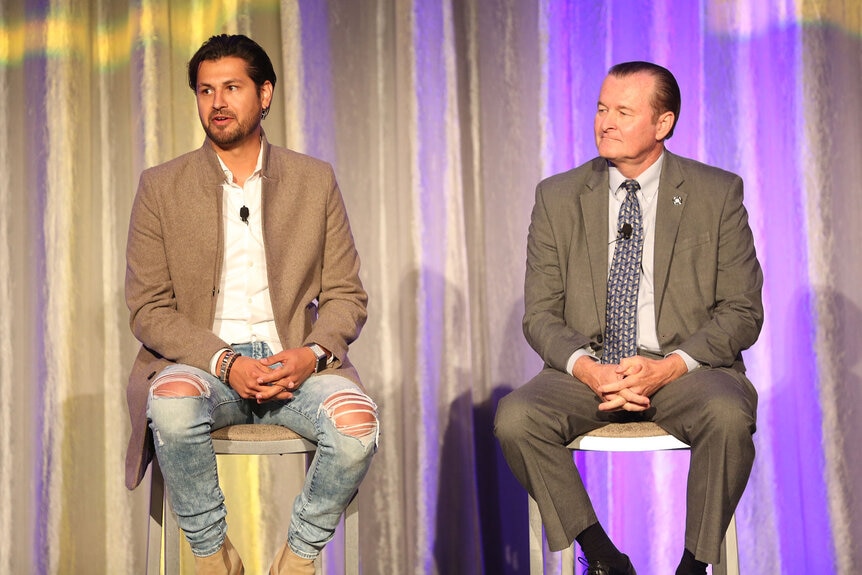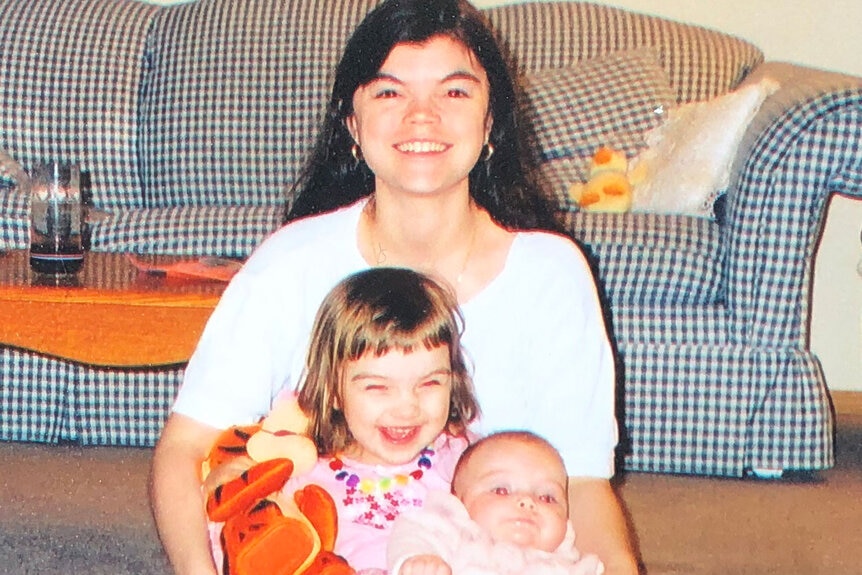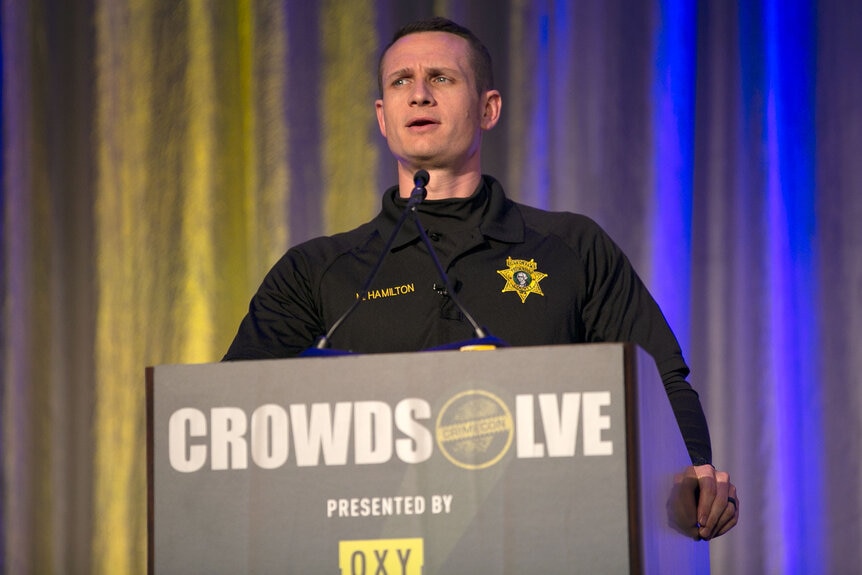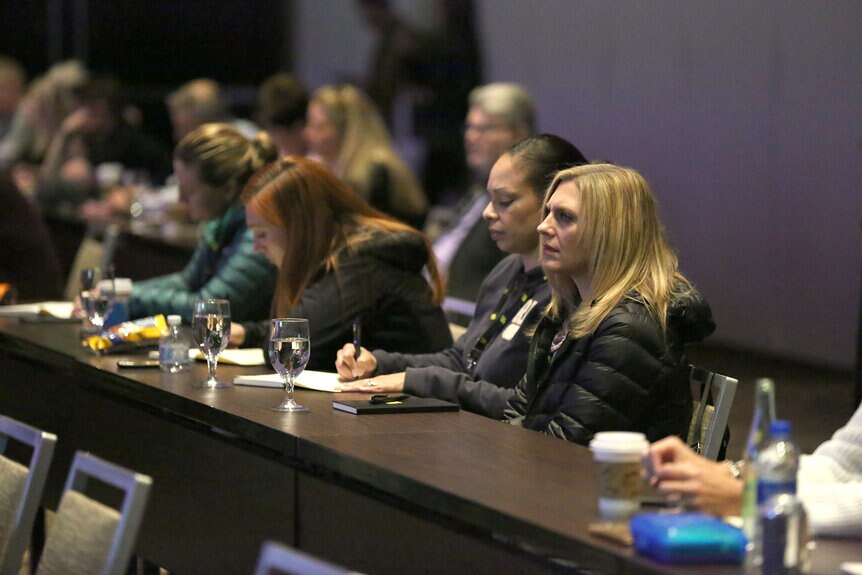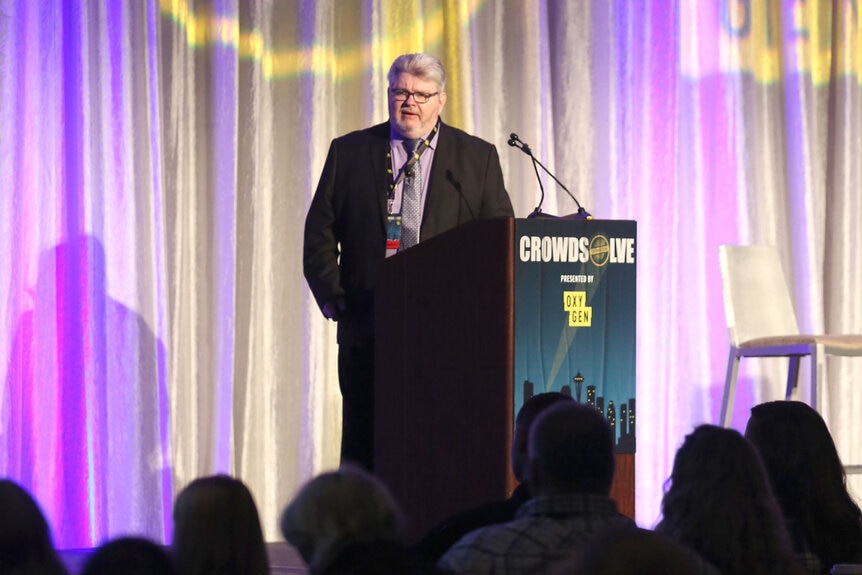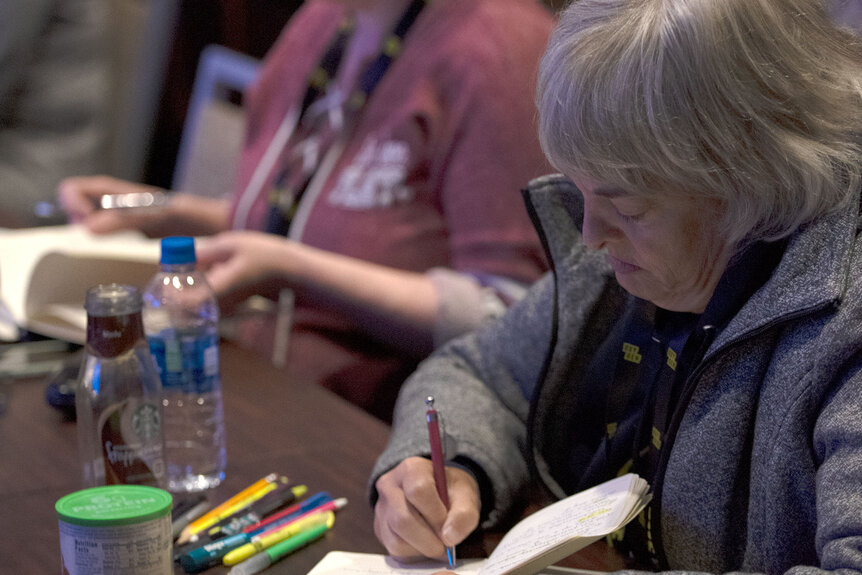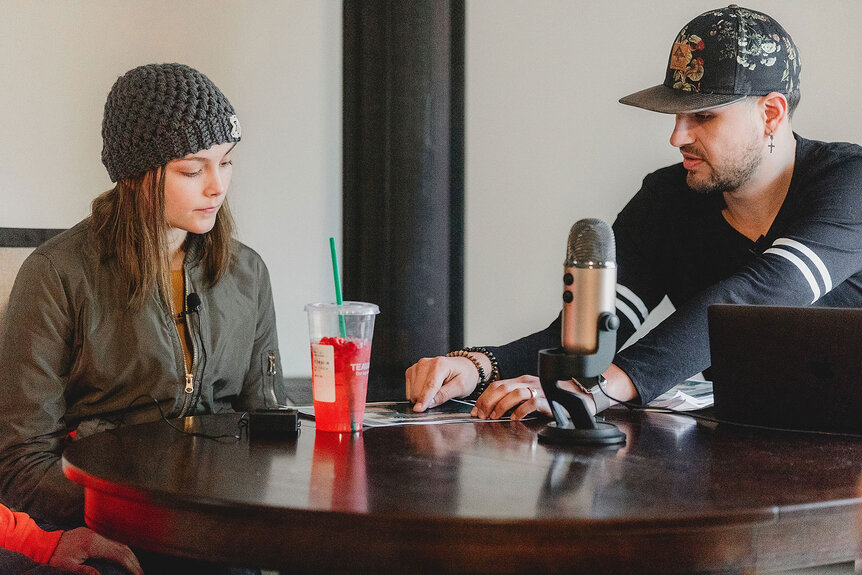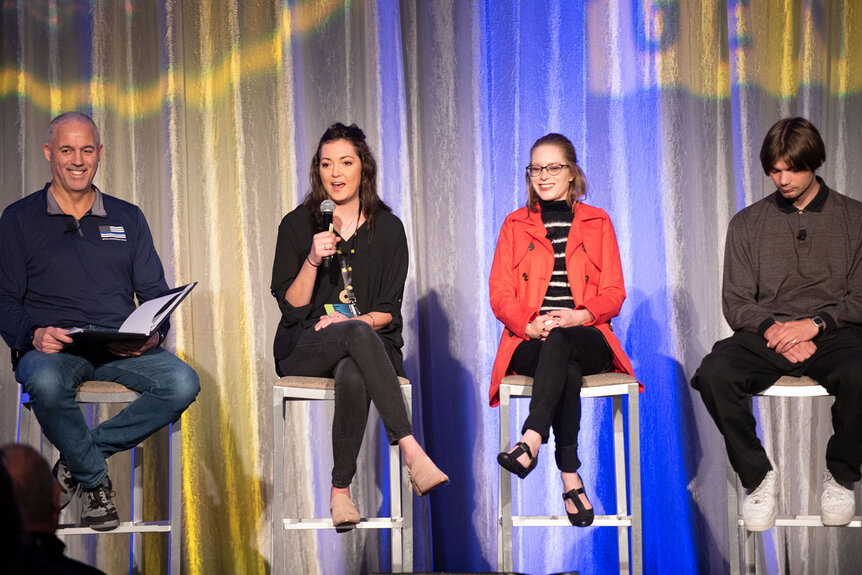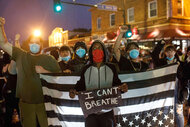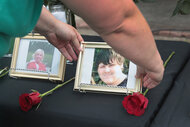Create a free profile to get unlimited access to exclusive videos, breaking news, sweepstakes, and more!
‘We All Want Justice:’ Could Crowdsolving Be The Next Frontier For Cracking Cold Cases?
Nearly 300 people gathered in Seattle to try their hand as detectives. Can they figure out what happened to Nancy Moyer and Karen Bodine?
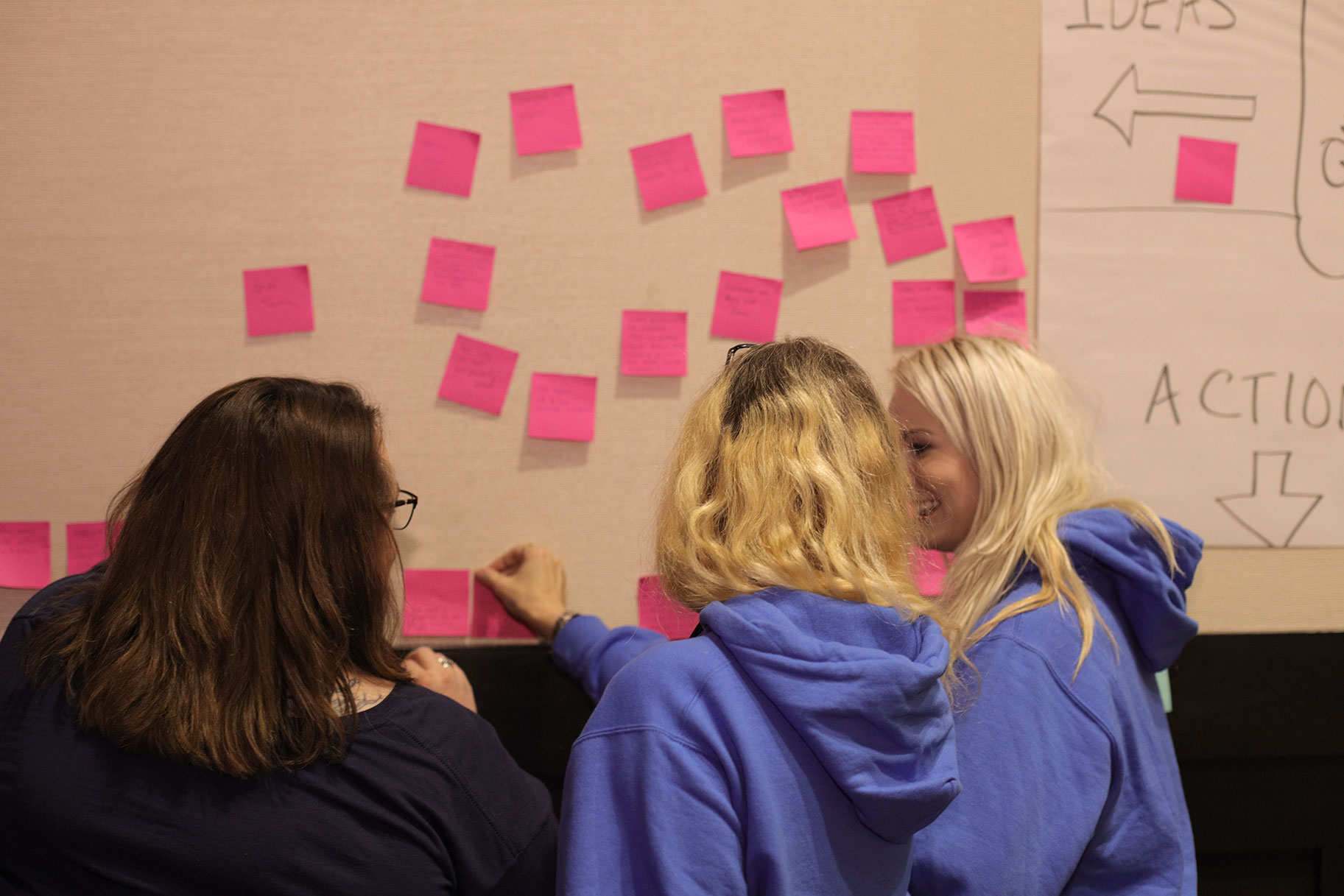
I had pitched myself to be the Oxygen staffer that went to check out CrimeCon CrowdSolve in Seattle, but as the date got closer I wondered what the eff I was doing.
My work days are full of disappearances, murders, serial killers, rapes. Did I really want to spend all weekend in a hotel conference center learning more about ligature marks and looking at old casefiles with a couple hundred strangers who were not only doing this voluntarily, but were spending upwards of a couple hundred dollars just for admission?
That high admission actually made Taylor Bodine, a daughter of Karen Bodine, feel better about participating. She thought it would “keep out the creepos and weird stalkers” who might be there just to gawk at crime scene photos of her mom who was strangled to death in 2007 and left nude at the side of a Rochester, Washington highway, her head resting on an old bucket seat of a car. Plus, the family had tried everything they thought of for the last 12 years to get justice. Why not give this a shot?
It was an experiment, after all. The organizers behind CrimeCon, which puts on true crime festivals in different cities, were branching out and partnering with a local law enforcement agency, asking them to open their files and give a bunch of amateur detectives a shot at things. Investigative journalist Billy Jensen has helped solve murders with crowdsolving. Todd Matthews, the first “internet sleuth,” helped solve a murder by researching online. Maybe the hive mind is the way forward.
Before I go any further, I oversee editorial on Oxygen’s website, which is a partner of CrimeCon. But while I do this work, I’m also a human person who, like a lot of other human people, has to think about what we do to earn a living. I think about critiques of true crime: that we glorify murderers. That we’re voyeurs. That we forget about the victims. That we package other people’s pain into entertainment.
I’m not going to defend myself, or an entire genre. But it is churning in my mind as I get ready Thursday evening for a premiere screening of “Searching For Nancy Moyer,” a video project that’s original for Oxygen.com and one of the two cases being covered this weekend. Moyer, a 36-year-old mother of two, went missing in 2009. A man, Eric Lee Roberts, allegedly confessed to killing her this year and then recanted. The Thurston County Sheriff’s Department has not filed any charges. Roberts maintains his innocence.
After the screening, attendees ask questions of a panel that include “Hide and Seek” podcaster James Baysinger, an insurance agent by day with strong Faith-era George Michael vibes. His podcast has brought the case into the national spotlight. Baysinger is joined by retired U.S. Marshal Art Roderick, the host of the whole event; lead case Det. Mickey Hamilton with the Thurston County Sheriff’s Office; Moyer’s ex-husband, Bill Moyer; her daughter, Sam Moyer; criminal profiler Dr. Maurice Godwin; and mayor of Tenino, Washington, Wayne Fournier.
The session lasts more than two hours, to where we are inching closer to 2 a.m. East Coast time, where my brain is still at from jet lag. Participants are going deep, asking about case and podcast minutiae. This is the first night! Don’t they want to get out and explore an area bar or something?
It sinks in. This is going to be a long weekend.
I convince myself to get out of bed in time to stop by Biscuit Bitch, a Seattle mini chain, for a gazillion-calorie Bitchwitch Egg Sandwich and a metaphor for my general disposition at the prospect of being in conference rooms all day.
The morning starts on some case basics, and there are lectures on how to build offender profiles from Dr. Godwin, an investigative psychologist who worked with podcaster Payne Lindsay on “Up and Vanished,” a podcast about the disappearance of teacher Tara Grinstead. The case had been cold for more than a decade, but after the podcast aired, law enforcement got a tip which led to the arrest of two brothers. Godwin also consulted on “Hide and Seek,” which depending on how you view the alleged confession and then recantation from Eric Lee Roberts, could give Godwin a decent batting average for shaking the tree on cold cases.
Then, we get an introduction on how to look at statements and tell when people are lying from Mark McClish, a supervisory deputy United States Marshal.
We break and I head over to Bill and Sam Moyer. I know this is hard for them. When Sam talked about life without her mom on the panel last night, she teared up. People are asking questions about her mom’s sex life, her sanity. Why do this?
In part because they had tried other things they were wary about at first. TV programs. The podcast.
When Baysinger initially approached Sam, he was just an insurance agent with no journalism experience. She asked to see his other podcasts and he explained this would be his first. She told him no, that when he first asked, she assumed he was “legit.” Baysinger kept at it and when she realized he was doing this podcast anyway and people seemed interested, she called him back up. In perhaps an act of hold-out hope, she had saved his number.
That podcast had led to going down to CrimeCon in New Orleans this summer, and meeting Dr. Godwin and Art Roderick, and Bill was impressed. It had led to the first movement the case had in years with Roberts’ alleged recanted confession. Maybe this CrowdSolve weekend would just keep shaking the tree, as Godwin would say.
They stayed all day. When attendees were broken into groups to take part of the hulking case file, Bill and Sam would walk around and answer questions about Nancy, from the mundane (how did Nancy store her cereal?) to the difficult (was Nancy bipolar?).
“What I liked was that no question was stupid and they were there to give us a better understanding of who she was,” Ashley Baker, who works in forensic psychology in the Bay Area, tells me. She came to the conference with her dad, a former corrections officer. She bought his ticket as a combination father’s day and birthday gift.
Baker had asked the question about Nancy’s mental health. She told me how important it was that people keep it professional with the families and not overstep.
She’d get to sessions early and sit in the front row sometimes. She was reading as much as she could.
“If you can make a little difference, to change how the investigators might see something, imagine what that can do for the family,” Baker tells me.
I sit and listen and keep thinking about how more than 600,000 people go missing in the United States every year, according to the National Missing and Unidentified Persons System (NamUs), and that 80,000 missing in 2018 were still missing at the end of the year, according to the National Crime Information Center. These are not thousands of people trying to ditch out on their families, or some soap opera plot where they have amnesia and then end up working in a Santa Barbara coffee shop. These are murders where there’s no body, or no crime scene, and no answers.
Bill describes not knowing what happened to Nancy as a “cloud” that hangs over every social interaction.
“It does affect our day-to-day and relationships, and I think an answer would help that go away,” he says.
At the end of the day, after hours of asking questions and presenting theories, the organizers collected the case files. While some things were off limits for authorities only, especially things to do with Roberts who is still considered an active suspect, these files weren’t publicly released and attendees had signed an NDA. Roderick continually reminded people that if they were going in public, don’t discuss the case too loudly. Keep this all within the group.
But, not that many people were going out. They had gotten a new case packet on Karen Bodine, the woman who was left by the side of the road, and they had work to do.
Saturday starts with more classes and most people are taking this more seriously than college, notebooks and questions at the ready about how to do an autopsy or how to process an outdoor crime scene.
Roderick then calls Bodine’s children up to the stage to give people a sense of “what Karen was like as a person.” Through a process of delicate questioning, we learn that Karen sometimes used drugs and sometimes she didn’t. The kids lived with their grandparents who had adopted them, and sometimes, the good times, Karen was there too and she was clean. The girls liked sharing a bathroom with her and they’d get out of some of their normal chores because Karen would make their beds.
When she wasn’t doing well, she’d walk around with a baby doll. It was a coping mechanism, her oldest daughter Karlee thought, because even if she had her kids taken away, she was a mother no matter what. She relapsed before she died.
I look at her son Tanner on stage, the youngest, and sometimes his eyes are closed or he’s looking down and he’s quiet. My heart feels too soft and porous for this and the grief in the room starts to feel like a heavy blanket and it’s hard to breathe. We break for lunch and I walk out into the rain and I walk and I walk and I walk to the open spaces of Olympic Park and the Space Needle then to the crowds gawking at men throwing fish at Pike Place Fish Market. Endorphins kick in and I start to feel better. I know I’ve been gone too long and I feel guilty and I walk back into the hotel conference center again.
I come back to Dr. Bill Smock leading a breakout group on what you can learn from ligature marks.
He’s a police surgeon that teaches other law enforcement about what the body can tell us about how someone died and how it might be misleading. He explains when people are getting strangled and they don’t die, that they don’t remember passing out, because the hippocampus doesn’t get enough oxygen and if you’re not getting oxygen there you can’t make memories.
I can’t help thinking about perhaps the most famous usage of the word hippocampus and that Dr. Christine Blasey Ford’s knowledge of how the brain worked gave her the tools to know how we process trauma, the kind we can’t remember and the kind we can’t forget.
When Sen. Diane Feinstein asked Ford during congressional testimony how she could be sure it was Kavanaugh that assaulted her, Ford, then a professor of psychology at Standford University explained the brain chemistry: the neurotransmitter epinephrine “codes memories into the hippocampus, and so the trauma-related experience is locked there, whereas other details kind of drift,” Time reported last year.
I wonder how many people here have been victims of crimes. The attendees are almost all women.
I think about how a decade ago, I’d come home from a job where I worked nights and watch a couple hours of Law & Order SVU. The closure rate on Law & Order is insane. Seriously, it’s got to be like 98 percent. There’s justice in the Law & Order land way more than in the real world. Olivia Benson, tough yet still maternal, almost always finds out who did it and she takes care of the victims. In the Law & Orderverse, the Brett Kavanaugh-ripped-from-the-headlines counterpart doesn’t keep succeeding in his career.
I think of me in my 20s, watching episode after episode. Maybe if you watch enough episodes where there’s consequences for the bad guy, you can just rewrite right over that hippocampus.
Later I find Dr. Smock and ask him what he thinks of the crowd. He’s used to teaching law enforcement, doctors and nurses and not the lay public.
“I found the audience extremely interactive and they asked very intelligent and thought-provoking questions,” he tells me, his language precise like his presentation. “They had read the material and came prepared, they presented potential theories that had merit. I was impressed with their interest.”
He thought that part of people coming here had to do with TV, of people watching detectives on true crime shows, or fictional shows, and thinking they could do that, and this was a chance to do it looking at real, actual cases. But some of it came down to wanting to right a wrong.
“We all want justice,” he says. “We want someone guilty of the crime to be held accountable.”
I saw a couple people grab portions of the case file, and tell an organizer that they need a break and will go up and read more later tonight in their hotel room. Others plan to work through the night, breaking off in small groups, exchanging numbers to text and meet up. I hear a woman offer up her room to meet. Det. Hamilton jokes that they are like real detectives staying up all night, existing on caffeine.
The next morning I find Dr. Godwin and ask him what he thinks. Why do people come?
He starts thinking aloud and saying that the crowd here is mostly female, but, so are a lot of victims.
“What makes killers who mutilate and do all these weird crimes tick, women definitely have the most interest in it,” he says.
I suggest that maybe understanding something makes people feel like they have a bit more control in a world where otherwise they don’t feel they have it. Maybe some of the people here have been victims of crimes, or have known victims. Maybe part of it is they are afraid.
“Exactly,” Godwin responds. “It’s about power. It gives them the sense of getting the power back, each time they give their opinion or find something new about the case and give a piece of information to authorities that might catch that individual.”
People break out into smaller groups to discuss the MMO (cop jargon for motive, means and opportunity) for different suspects in the Bodine murder. I realize I’m sitting in the same row as her children, that I’m supposed to head to the airport soon and I haven’t talked to them. I want to know why they agreed to be here and talk about their mom to all these strangers.
I don’t miss one single thing about being a cops beat reporter right out of college, knocking on doors, asking the people inside about the worst days of their lives. Karen’s kids look exhausted and I don’t want to be one more person bothering them. But I tell myself to toughen up and approach them.
I head toward Taylor, the chattiest one during the earlier question and answer session. She looks like she’s been crying.
She’s the one that tells me that she was a little unsure when she first heard about the idea, but that if people were willing to fork over money and time, that maybe they were for real.
“It’s great that people took the time of their own lives to get up early and stay up late and work this whole weekend,” she says. “We’ve been working on this ourselves for so long.”
As we talk, two cousins that came for the weekend lean in and contribute, as well as her siblings. They tell me that someone that violent shouldn’t still be out there on the streets. They want someone held accountable. Karlee, Karen’s oldest daughter, tells me that it’s unfair that you have to pay parking tickets, settle up minor infractions, and no one has ever paid for killing her mom.
I catch up with Det. Hamilton and his wife. He’s the platonic ideal of a law enforcement partner for this sort of thing, smart and affable and encouraging of the participants. His wife is one of the participants, taking notes through sessions. She tells me she’s been interested in true crime since she was a kid, and kept a scrapbook on the JonBenét Ramsey case.
Throughout the weekend Roderick has said how great it is Thurston County was ready to try crowdsolving, and that a lot of sheriff’s departments wouldn’t have just opened up their files this way. While I’m chatting with the Hamiltons, Roderick comes out and whispers to him that someone that knows Nancy is here, and wants to talk to him. It’s the second person that’s come to CrowdSolve that knew her and hasn’t spoken to law enforcement before now, Det. Hamilton tells me. He doesn’t know if it will lead to anything, but when a case goes so cold, any detail gives some hope.
I gather up my bags and see Roderick on the escalator and introduce myself. He tells me he thinks something will come out of this weekend. I hope so.
I think about the people that have come here with their friend, their mom, someone they convinced to buy a ticket or saved up money to come alone. I remember tearing up watching a woman in her 30s spot two open seats before a new session begins and say “hey dad, I found us seats over here.” I don’t know her story, or his, but something about these people here with other people who want to keep them safe gets to me, because we can’t always protect the people we love. The world gets in the way. But maybe if we team up, we can figure a bit more of it out.
CrimeCon CrowdSolve is tackling another case in February in Chicago. Learn more here.
